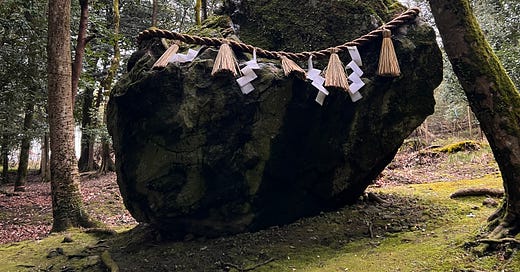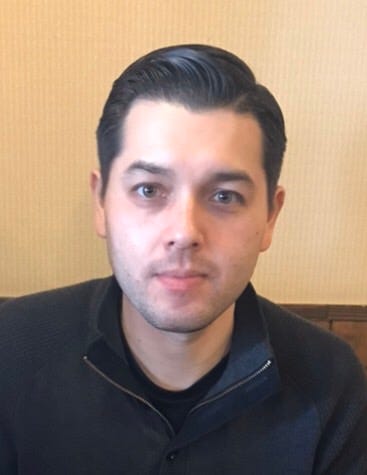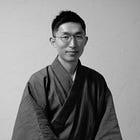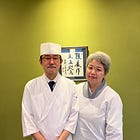72 Seasons of Tea | Instagram | LinkedIn | About
#3 Conversations Mostly from Kyoto
Matt Fujimoto
From the sacred white paper streamers in Shinto shrines to the white outfits of factory workers, chefs, Shinto priests, and even taxi drivers in white gloves and white seat covers - white is more than just a color in Japan. It is a visible expression of purity and a deep cultural value placed on cleanliness.
- Matt Fujimoto, Writer of Freelance PhilosophyI love Kyoto for its nature, and for its spiritual and scholarly vibes.
It is only in Kyoto that I got to meditate with Zen monks, walk through tea fields with fellow tea lovers from around the world, and spend the day practicing mindfulness with scholars and students in the serene expanse of a traditional cultural villa, overlooking a Japanese landscape garden and its quaint tea house.
It is here that I got to meet people who truly love philosophy, culture, and nature.
Recently, I sat down with
on a warm sunny day in the calm retreat of the Kyoto Imperial Palace Park, surrounded by towering trees and its lush green spaces.Matt Fujimoto is an editor and writer. He edits Philosophy Today and Language is Life, and writes a Substack newsletter called Freelance Philosophy. Matt moved to Japan in 2017 to research Japanese philosophy of language at Kyoto University.
In this wide-ranging conversation, we covered nearly everything under the sun:
Becoming a philosopher
Awe, Shintoism, and the reverence of nature
Being a parent in Kyoto
US-Japan: Individualism, community, changing cultural views on motherhood
Kyoto, off the beaten path
Asking good questions
I am grateful to philosopher for introducing me to Matt. See his previous interview with Matt.
What brought you to Kyoto?
I am half-Japanese and grew up in the United States. Before becoming a researcher of Japanese Philosophy here in Japan, I had visited the country five or six times.
One of the reasons I chose Kyoto was practical. The application process was simpler than other universities such as Tokyo University. Kyoto University is a very traditional university and places more weight on professor recommendations, making things easier on visiting researchers. Eventually, I got married and decided to settle down in Kyoto, where my wife is from. Having spent most of my life in the States, I was especially drawn to the idea of living in another country long term.
What inspired you to become a philosopher?
What I really love about politics is actually the philosophy.Initially, I wanted to work in the government and foreign affairs so I studied Political Science during my undergraduate. A class that deeply influenced me was Philosophy of Social Issues, which covered ethical questions through political and philosophical debates on topics like abortion, and same-sex marriage, euthanasia, and war.
In my undergraduate studies, most of my philosophy work focused on German philosophy. It is a fitting connection as Japan has a deep historical connection to German philosophy.
During the Meiji period, as Japan opened to the world, it actively studied and adopted ideas from abroad: business practices from the US, government systems from the UK, medicine and philosophy from Germany.
By the time I graduated, I had shifted my focus from political science to philosophy, realizing it was my true passion. I went on to pursue it in graduate school, with a growing interest in Japanese philosophy, shaped in part by my half-Japanese heritage.
There is a distinction between philosophy in Japan and Japanese philosophy: 1) Philosophy in Japan refers broadly to philosophical work done in Japan 2) Japanese philosophy is more culturally rooted, reflecting a distinctly Japanese worldview. Japanese philosophy blends Buddhist, Confucian, and Shinto ideas with Western thought - grounded in Japanese culture.What does a philosopher do? What do you specialize in?
In the context of a profession, a philosopher often works as a university professor. This role typically involves a combination of teaching, research, and service. Teaching includes designing, leading courses, and mentoring students. Research involves producing original scholarly work through reading and thinking, working out arguments, publishing, and presenting at conferences for feedback. Service means participating in university committees and organizing departmental events.
I focus on the question of existence or metaphysics through the lens of the philosophy of language. I ask questions to explore how language works at a fundamental level:
How does language have meaning?
How do words, symbols, and sentences actually convey what they intend?
What is the difference between positive and negative statements like “it is hot” vs “it is not hot”?
Where does meaning reside: in the words themselves, in the structure of the sentence, or in our use of them?
How do symbols and signs function? How do they refer to or represent things in the world?
A philosopher generally investigates one of the three main philosophical questions: What is knowledge? What is existence? What is good or ethical?What is Shintoism?
Shintoism is Japan’s indigenous spirituality — a decentralized, living tradition grounded in nature, and the reverence for the unseen. Unlike Buddhism, which has structured teachings and schools, Shintoism has no central church, no single theology, and no governing authority overseeing doctrine. Each Shinto shrine is independent, with its own beliefs and practices that often vary from one place to another.
Shintoism embraces awe as a lived experience tied to nature, in the trees, in kami, and the world around us — deeply felt in everyday life — while much of Western philosophy, with its religious roots, often treats wonder as an intellectual concept.
In Shintoism, there is no separation between nature, humans, and the spiritual.
Often, kami is translated as “God,” but that can be misleading. It can also refer to local spirits or ancestors that stir awe. A tree and the kami are one. They are interconnected.
Kami is what inspires awe. Why does that tree have kami? Perhaps a better question is: Are we too busy to feel that the tree - and the world around us - are also kami? Shintoism reminds us to stay open to this quiet, everyday wonder.
Cleanliness is also a central value in Shintoism. Most Shinto shrines have a mirror, often hidden from plain view. The mirror stands for purity and reflection. We get dirty simply by existing so if our inner “mirror” is dirty, we cannot truly reflect the world around us well.
In Japan, cleanliness is a core cultural value, representing spiritual clarity and a deep reverence for the invisible presence in nature. We see it in people’s widespread preference for white color — from the sacred white paper streamers in Shinto shrines to the white outfits of factory workers, chefs, Shinto priests, and even taxi drivers in white gloves and white seat covers.
White is more than just a color. It is a visible expression of purity and a deep cultural value placed on cleanliness.
So how do you make philosophy practical?
Modern life is fast. It’s harder to slow down and take time to think about things. But easier to skip and jump on to the next video.The podcast for my newsletter brings philosophy to the public through everyday conversations, using current events, real-life issues, and public news stories to explore ideas with a philosophical lens and spark meaningful discussions.
Through my podcast as a free-form lecture, I introduce key ideas and vocabularies. I show why it’s important to think critically, question assumptions, and evaluate arguments with clarity and evidence.
Philosophy is about keeping the conversations going. I have explored a wide range of topics, from the elderly and children caregiving to Trump, causation, and tariffs.
What’s working for you as a parent living in Kyoto?
Kyoto has good public schools that care not only about academics but also the cultivation of manners, discipline, and social behavior in children. It also has strong governmental support to families such as financial aid, discounts, and free events. Just last year, I took my family to enjoy some Kyoto Sanga Football Club games with free tickets.
On the flip side, culturally, children often seem undervalued in Japan. There seems to be a common belief that kids aren’t seen as full individuals until at least middle school. Kids are often viewed as a nuisance in everyday society.
This means that families with young children do face challenges in public spaces. For example, there is a general lack of consideration for priority use of elevators when pushing strollers. On crowded buses, few offer their seats to families with young kids. In restaurants, noisy children often get disapproving looks of glares instead of understanding.
How can we rebuild community in a more individualistic society?
I think it is easier to rebuild a community in America than in Japan. Simply, there is a difference between Japan’s external shame culture and America’s internal guilt culture. Japanese society is largely held together by external pressures, like shame or the fear of being outcast. Its societal expectations and demands are high so younger generations have a preference to be left alone. As people in Japan become more financially independent and live alone, such external pressure weakens.
By contrast in America, there is this internal motivation that values and craves for a sense of community. This intrinsic motivation makes it easier for people to connect naturally, rather than relying on external pressures to create that bond.
“Why aren’t 40 year olds getting married in Japan?” is a question my colleague is exploring. Her work illustrates that women now have more independence and freedom from social expectations than before.
Abenomics with its policies to revive Japan’s economy had encouraged women to join the workforce to address labor shortages and boost productivity, but this created new pressures on families. It came at the cost of connections as families found it harder to maintain close connections with their children and aging parents, while traditional roles and time for caregiving were strained.
In addition, city living and urbanization have weakened traditional communities and family involvement in marriage, traditionally bonded through the omiai お見合い or mate-introduction system via the parents or grandparents.
Building a stronger sense of community requires a cultural shift. The low birth rate, for example, is not just an economic issue. Changing how society values motherhood and children is far more important than simply pouring money into fixing the symptoms.
What else do you like about Kyoto?
“I like to drink green and black teas. It’s hard to find bad tea in Japan, even from convenience stores or supermarkets.” Kyoto is a good city — big but not overwhelming. Kyoto has plenty of green spaces like the Imperial Palace, Kamogawa river, botanical garden, and numerous temples and shrines.
In fact, shrines are freely accessible to the public, unlike temples. While there are still many multiple off-the-beaten-path areas, few remain truly hidden — thanks in part to Google Maps for revealing secret sakura viewing spots, for instance.
Personally, I would recommend exploring these alternative sites:
哲学の道 Tetsugaku Nomichi - Philosopher’s path
城南宮 Jonangu - Shinto shrine famous for camellia, weeping plum trees, and flowers associated with the famous Tale of Genji
長岡京 Nagaokakyō - The capital before Kyoto
滋賀 Shiga in the broader Otsu area.
I do translation work with the Kyoto Prefecture Tourism Association to promote day trips to the following locations outside of Kyoto city. The challenge is that accessibility is generally limited to cars.
京丹後 Kyotango - North of Kyoto prefecture, known for its traditional thatched-roof houses, local crafts and pottery culture
綾部 Ayabe - Central-North of Kyoto prefecture, known for its traditional textile heritage and spiritual sites with ties to the Omoto religion
福知山 Fukuchiyama - Northwest of Kyoto prefecture, known for its historic Fukuchiyama castle
亀岡 Kameoka - West of Kyoto city, known for its agricultural landscape and proximity to the metropolitan area
宇治 Uji - South of Kyoto city, famous for its tea culture, historic temples, and proximity to the metropolitan area
What gives you hope as a philosopher?
People are resilient and will find ways to survive, even if that means not becoming all they are truly capable of. Eventually, when things get bad enough, people will step up to fix the problems we now face — from the environment to human rights. But that probably means things will have to get worse before they get better.
Life is complex. Because of this, asking good questions is far more important than having all the answers. If we rush to ask only narrow answers, we get simple answers, carrying blind spots along that do not consider the bigger picture or the unintended consequences.
Good questions open our minds and reveal what’s beyond the obvious. They make us think critically, weigh all factors, and consider better options. Rather than chasing quick fixes that might cause new problems down the line, good questions guide us towards wiser and lasting solutions.
Because how we ask matters just as much as what we answer.
See Matt’s recent post - Philosophy Isn’t the Answer You’re Looking For.
For more information on Matt Fujimoto
Freelance Philosophy on Substack











Thanks for this great, wide-ranging interview with Matt, Peck Gee.
There are a very Shinto-specific sites here on substack which I follow, written from practitioners. They provide great insight into this nature-based religion.
Thanks for introducing some different, historical areas outside Kyoto. My daughter recently visited, so I did a bit of electronic exploration. "Kyoto-by-th-sea" looks beautiful, with "boat house" were the bottom floor is not a garage for cars but a dock for the household's boats!! Have you been there?
Thanks for presenting something about Shintoism, Matt. That philosophy has escaped my awareness up to now.
As to "Eventually, when things get bad enough, people will step up to fix all the problems we now face — from the environment to human rights.", I wish that was true. As things get worse, people become more desperate, which often evokes more fight/flight than strategic thinking. Sad.
Thanks for this nice presentation on your publication, Peck!